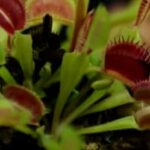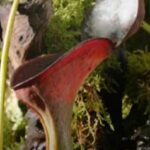As an Amazon Associate, this site earns commissions from qualifying purchases. For more details, click here.
Pitcher plants use their pitcher to trap bugs and eat them. But what if a dead insect falls inside it, or you drop one that has died? Will the plant consume it? In this article we will go over the types of bugs pitcher plants can eat, and foods you must never give it.
Pitcher plants eat live and dead insects as well as mealworms, fish pellets and fish flakes. These plants can be fed one bug a week, though once a month is enough for some species.
What Live and Dead Bugs Can You Feed Pitcher Plants?
Pitcher plants get food from the sun through photosynthesis, so bugs are not necessary for their survival. But insects provide essential nutrients that help them grow and stay healthy.
If you want to keep things simple, you can give the pitchers Aquatic Foods Bloodworms, as they provide essential nutrients. With these you don’t hav to worry if your plant is catching any live prey. Just drop a few of these bloodworms in the pitchers and you are done.
The following are safe for pitcher plants to eat. You can buy these in pet stores in person or online. If you are patient enough you can also catch live insects in your garden.
- Spiders
- Flies
- Ants
- Moths
- Crickets
- Gnats
- Mosquitoes
- Ladybugs
- Grasshoppers
- Fish pellets
- Fish flakes
- Live worms: only small ones. Large worms can crawl out of the trap or worse eat through it.
- Slugs, butterflies and caterpillars: if they are small enough. Large ones might eat the leaves.
- Beetles and cockroaches: they have hard shells which a small pitcher plant might have trouble breaking down. Adult plants however should have no trouble digesting them.
And in case you are wondering, pitcher plants cannot and will not eat humans.
Pitcher plants can eat almost any insect if it is small enough. It does not matter if the bug is dead or alive. When an edible prey falls into its trap, a pitcher plant will release digestive enzymes. This, combined with the liquids in the pitcher, dissolves the insect.
The liquefied insect is absorbed into the plant along with its nutrients. These are converted into nitrogen and other elements pitcher plants use to supplement their food intake.
All pitcher plants grow in poor soil, but by eating insects they are able to absorb nitrogen. This is also the reason why they do not need rich, fertilized soil.
Foods You Must Never Give Pitcher Plants
Processed meat, fruits and other foods for human consumption should never be given to pitcher plants. These include but are not limited to:
- Sausages
- Steak
- Beef jerky
- Turkey
- Chicken
- Canned meat
- Bacon
- Ham
- Salami
- Hotdogs
- Fruits
- Candies
- Chocolates
- Cheese
- Canned goods
Do not feed mice, frogs, toads, birds, lizards or fish to pitcher plants. Can these plants actually eat these animals? There are reports of mice being found in wild pitcher plants. The problem is these animals might decompose inside the pitcher, causing it to smell and produce an infection.
How to Feed Pitcher Plants Step by Step
Feeding pitcher plants is very easy. Follow these steps.
- Choose what food to give it. Dead or living bugs, it is up to you. If you are giving it freeze dried worms or bugs, re-hydrate it first with a few droplets of distilled water like RPI Distilled Water.
- Drop the food into the pitcher. Use a pair of chopsticks, tweezers or your fingers.
- Repeat this for each pitcher plant you have. Again, they only need to eat once a week or once monthly.
You can give any of the food options listed earlier. If your plant has never eaten freeze dried food before, give it only a small amount.
Observe the plant for a week or two for its reaction. If it seems fine, you may continue feeding. Stop immediately if you notice the leaves turn brown or fall off. Use the same approach with fish food or any new bug that you want to give.
Freeze dried pitcher plant food sold in stores provide the same benefit as live and dead bugs. Outdoor plants do not require assistance feeding, but if yours is indoors, it is easier to buy pitcher plant food from the store or online.
Killing bugs is difficult especially if you have several plants to feed. If you happen to find a dead bug, make sure it has not decomposed. Do not give rotting insects to pitcher plants as it could lead to fungal infections.
Be careful if you are going to feed living worms, slugs or caterpillars. Small ones are probably fine, but adult sized worms can eat through leaves. It is better to cut off the head and then drop it into the pitcher. This eliminates the possibility of it escaping.
Even then, it is better to feed small amounts of food. A large, dead worm cannot escape. But the plant may not have enough digestive fluids to break down its tissues.
Pitcher plants only need small amounts of food. Chances are, substantial portions of the worm will be left to rot inside the pitcher. This can cause problems so it is best to keep food portions small.
Do Pitcher Plants Require Feeding?
Outdoor pitcher plants do not have to be fed. They can capture insects without any help. But indoors they have limited access to food so manual feeding is required.
With sufficient sunlight and water, pitcher plants can live without eating insects. But live or dead bugs provide extra energy, similar to how vitamins boost our strength.
If your plant is outdoors you can dispense with the manual feeding. Flies, spiders and all kinds of insects will end up in its pitcher. Check the pitchers every now and then to ensure the plant is eating.
If your plant is indoors its access to food is limited so feeding might be necessary. It is all right for pitcher plants to eat just once a month, so if it catches a housefly or mosquito, no need to feed. But if the pitcher is always empty you have to give it food.
What happens if you do not give food to pitcher plants? The plant will still live if it has enough sunlight, water and moist soil. But it will not reach its maximum growth potential. Its traps will produce very little nectar and appear lethargic.
The worst part is unfed pitcher plants become vulnerable to disease. Think of a human being who does not take any vitamins or minerals. They will survive by eating, but without vitamins their immune system is compromised. The same applies to pitcher plants.
Tips For Feeding Pitcher Plants
Now you know how easy it is to feed these plants. Even so there are certain things you can do to make it even simpler.
- Make it easy on yourself. Unless you like catching bugs, it is easier to buy food for your pitcher plant. They are readily available online.
- Do not overfeed. If the plant already catches bugs on its own, no need to give any more food. The plant will not eat it and those insects will just decay in the pitcher.
- Have tweezers ready. For one thing, insects are very small and you could lose them. Second, not everyone likes the idea of holding dead flies and worms. So get some tweezers for simpler plant feeding.
- Avoid hard shelled bugs. Cockroaches, beetles and other bugs with hard shells require more digestive liquids to dissolve. You can make things easier for your pitcher plant by feeding them worms and bugs with softer shells.
- Cut the food into several pieces if necessary. If you want to give your plant a large bug, cut into chunks for easier digestion.
- Pitcher plants need regular feeding during the growth period. If your variant goes dormant – sarracenia pitcher plants for example – they will not eat during that period. This is normal.
Conclusion
Feeding pitcher plants is really easy and if the plant is outdoors it will catch prey without any help. If you do give it food, remember not to overfeed. If you want to give it a new type of bug or freeze dried food, observe its reaction and stop feeding if the leaves start to wither.

My fascination with carnivorous plants began many, many years ago with Venus Fly Traps. Now I am more than happy to impart what I know with other enthusiasts and those who are curious about meat eating plants.



